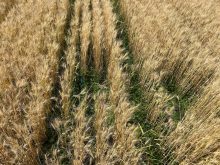Nitrification inhibitors have sometimes struggled to prove their worth on farm balance sheets, but research is still hinting the products could pay their way.
Early results from a multi-year University of Manitoba study suggest it might be possible to shave nitrogen fertilizer rates by 10 per cent or more when paired with the right products.
WHY IT MATTERS: Fertilizer costs are high, while fertilizer efficiency is continually being pushed thanks to federal emission reduction targets. Nitrification inhibitors, including best practices and their efficacy, are one feature of the conversation.
Read Also

Made-in-Manitoba sunflower hybrid headed to market
Manitoba’s confection sunflower growers will have a new seed option next spring developed specifically for performance in the province. The…
The research is led by Mario Tenuta, research chair in 4R nutrient management at the U of M, in collaboration with Manitoba Agriculture’s Manasah Mkhabela. There are four sites across different growing regions of the province, including the Prairie East Sustainable Agriculture Initiative (PESAI) in Arborg, Roblin, Melita and Carberry.
The study was launched in 2023 in response to Ottawa’s target to cut nitrous oxide emissions from fertilizer by 30 per cent by 2030.
Inhibitors and greenhouse gas emissions
The team’s goals were twofold: measure nitrous oxide emissions under different nitrogen rates and test whether nitrification inhibitors could curb losses without affecting yield. Plots were set up with zero, 70, 90 and 100 per cent of recommended N rates, both with and without nitrification inhibitors. The same treatments stay on the same ground each year to track the impact as soil reserves change over time.
Rotation on the plots began with canola in 2023, followed by wheat in 2024 — the only season from which full yield and emissions data are available so far. The study is ongoing.
Rebalancing the nitrogen equation
For farmers, the takeaway may be less about adding bushels through less nitrogen loss (and therefore more nitrogen availability) than about widening the profit margin by applying less fertilizer with the same yield.
The additional cost of inhibitors has been the complicating factor in that efficiency argument. Tenuta’s own earlier work suggests the products don’t reliably boost yield on their own.
“They reduce nitrogen losses, but farmers are already applying enough N that having more in the system usually doesn’t help them,” he said.
For farmers to see a robust economic argument for inhibitors, there must be enough room to strategically trim nitrogen rates, without yield impact, to offset the extra cost of adoption. The thought is less about cutting nitrogen application so much as rebalancing overall soil nitrogen.
Results and insights
A single year of data doesn’t offer much rigous data, but there have been some initial insights.
On the emissions side, apart from an anomaly at Roblin, inhibitors performed as expected.
“At the Arborg site, nitrous oxide dropped 23 per cent when we used a nitrification inhibitor,” said Mkhabela during a July field day at PESAI this summer.
There were comparable reductions recorded at Melita and Carberry.
Yield appeared to be unaffected by the inhibitor in 2024, but results suggest the soil at that time still held significant nitrogen reserves. Wheat grown with 100 per cent of recommended N averaged 64 bushels to the acre (bu./ac.). At a 10-per-cent reduction plus inhibitor, yield held at 63 bu./ac. Even at 30 per cent below the recommended rate, yield only dropped to 57 bu./ac. Unsurprisingly, the plots without extra nitrogen fell behind on yield, at 37 bu./ac.
Lags in plant impact to applied nitrogen, however, encourages researchers to be a little careful in speculating how deeply farmers can cut.
A 10 per cent rate reduction is low-risk, Tenuta noted, but much bigger cuts are more of a gamble.
Nitrogen stored in soil continues to feed the plants long after the last application of the nutrient. The more agressively nitrogen rates are reduced, the more quickly soil reserves will be depleted.
“If we drastically reduced nitrogen by 50 per cent, we probably wouldn’t see an effect in 2026,” he said. “But by 2028 we’d really see it.”
Similarly, the respectable yields Mkhabela observed with a 30 per cent nitrogen reduction will almost certainly diminish over time.
The long-term goal is to find that sweet spot: the lowest nitrogen rate that will consistently deliver good yields.
When asked where he thought that sweet spot would end up, Tenuta was conservative. Based on wider research, he guessed it would land in the neighbourhood of 10 to 15 per cent.
That might not be dramatic enough to get producers lining up to change long-held habits, he acknowledged.
“Nitrogen management is so ingrained in us,” he said. “We always think about going up, not down.”

Perception matters
Manitoba Agriculture farm management specialist Darren Bond broadly agreed, saying the decision isn’t only economic; perception matters, too.
Regardless of what the research says, producers will ultimately be the ones to pull the trigger on a management change.
“Is there benefit if you cut nitrogen 10 per cent and add an inhibitor? Maybe. Maybe not. Either way, we’re dealing with slivers,” said Bond.
He also noted environmental conditions can swing yield by 25 bu./ac. If farmers are asked to make decisions over pennies while weather can rewrite the whole outcome in a day, motivation tends to diminish.
“Mother Nature bats last when it comes to this type of stuff. That’s why producers are reluctant to cut nitrogen,” Bond said.
With a little more data, however, Bond noted the mental calculation on the issue could shift. That same nutrient-application-to-impact lag means that short trials tend to flatter aggressive rate reduction insights. For field studies like this, where changes unfold incrementally over years, longer trials are needed.
“Let’s go past three years to four, five, even 10, and start seeing what really changes,” Bond suggested.
The study’s long-term scope isn’t locked in yet, but Mkhabela told the PESAI tour crowd that the team is aiming for 10 years of funding.
Keeping it real
Current policies are adding another layer of consideration to the debate.
Government has launched a number of funding streams meant to bolster fertilizer efficiency in the wake of their 2030 emission goals. Those include subsidies and incentives through the Sustainable Canadian Agricultural Partnership (S-CAP) and other programs that may fund dual-inhibitor products, combining nitrification and urease inhibitors to offer additional benefits for growers.
“Urease inhibitors are like an insurance product to allow that nitrogen to get into the root zone and become more stable,” Bond explained. “The nitrification inhibitor is mainly impactful on greenhouse gases.”
Persistently tight margins could also change the outlook, he noted. When nitrogen was cheap, farmers just applied more urea to buffer against nitrogen losses. If prices rise and margins narrow further, the efficiency gains from nitrification inhibitors could start to look a lot more compelling.
Tenuta says it’s important not to over-promise with these products. Enhanced-efficiency fertilizers, including nitrification inhibitors, can play a role, but farmers need a clear-eyed view of what they can and can’t do.
“I don’t want good practices, and these products, to get a bad name,” he said. “If we can show farmers they can reduce losses and maintain profit, that keeps nutrient stewardship moving in the right direction. That’s the take-home message here.”
















